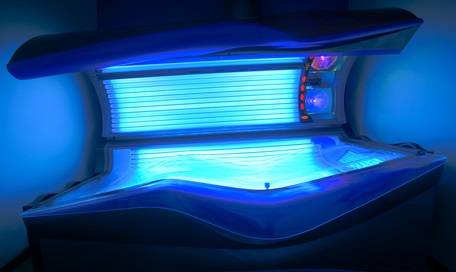SUMMARY: It is estimated that in the US, about 87,110 new cases of melanoma will be diagnosed in 2017 and about 9,730 patients will die of the disease. The incidence of melanoma has been on the rise for the past three decades. A major risk factor for most skin cancers is exposure to UltraViolet (UV) radiation, which damages the DNA of skin cells. The main source of UV rays is sunlight, tanning lamps and tanning beds. UV exposure also can cause cataracts and ocular melanoma. Indoor tanning, exposes individuals to both UVA and UVB rays and is particularly dangerous for those who begin indoor tanning during adolescence or early adulthood, putting them at a higher risk of developing melanoma. The association between indoor tanning beds, including those with the newer tanning technology, and melanoma, has been well established with a 22-34% increase in the risk of developing melanoma with indoor tanning. The International Agency for Research on Cancer has classified indoor tanning as a Class I carcinogen, based on its significant association with malignant melanoma. Indoor tanning with resulting exposure to ultraviolet radiation is a potentially modifiable behavior. According to the 2015 Youth Risk Behavior Surveillance System, approximately 15% of the high school teens are indoor tanning and according to the 2010 National Health Interview Survey, indoor tanners tended to be young, non-Hispanic white women of whom 32% are aged 18 to 21 years.
The authors in this study estimated the health and economic benefits of reducing indoor tanning in the United States. Using a statistical model that takes into consideration risk, that continues over time (Markov model), the authors estimated the number of melanoma cases and deaths that could be prevented and melanoma treatment costs saved, by reducing indoor tanning among minors younger than 18 years. These estimations were based on a cohort of 61.2 million individuals aged 14 years or younger in the United States and the probability of these individuals using indoor tanning, based on data from the 2013 Youth Risk Behavior Survey. The prevalence of indoor tanning was based on a recent meta-analysis.
The researchers noted that restricting the use of indoor tanning among minors younger than 18 years was estimated to prevent 61,839 cases of melanoma (4.9% reduction) and 6,735 melanoma deaths (4.7% reduction), over the lifetime of this group of individuals. The treatment cost-savings from these reductions was estimated to be $342.9 million over the lifetime of these individuals. These health and economic benefits increased as indoor tanning was further reduced.
The authors concluded that reducing indoor tanning has the potential to reduce melanoma incidence, mortality, and treatment costs, emphasizing the importance of continued public health efforts to identify and implement effective strategies to prevent melanoma. The potential impact of reducing indoor tanning on melanoma prevention and treatment costs in the United States: An economic analysis. Guy GP, Zhang Y, Ekwueme DU, et al. Journal of the American Academy of Dermatology 2017;76:226-233

